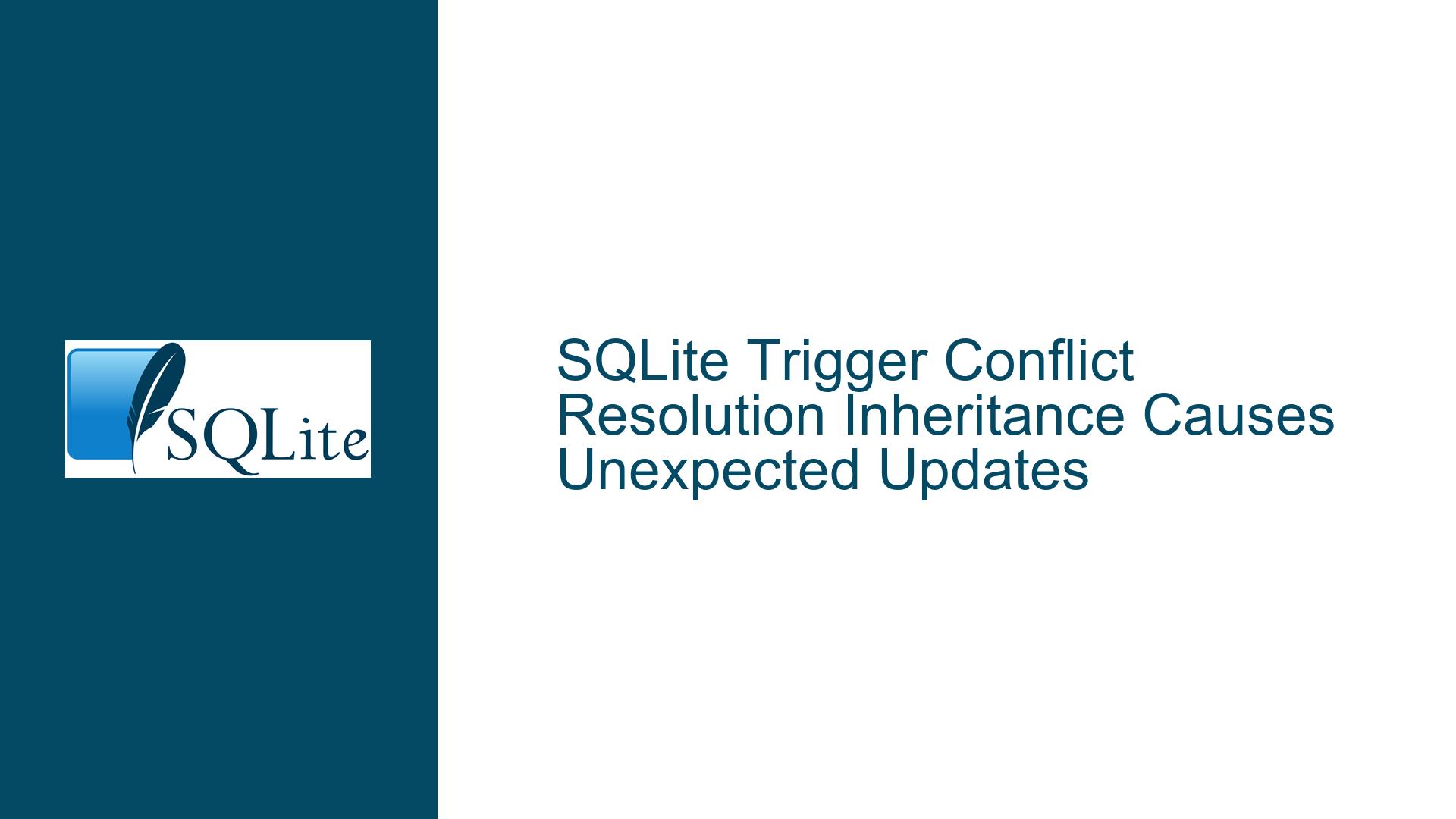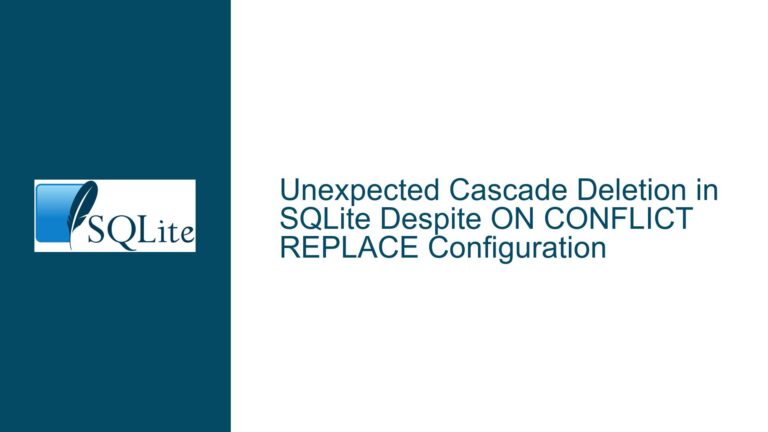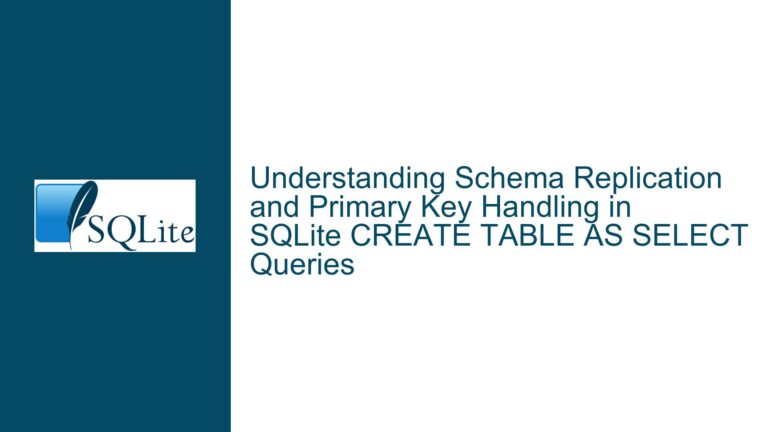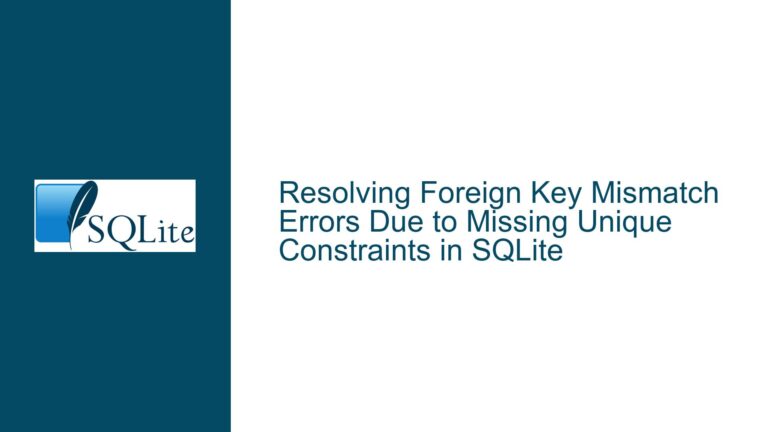SQLite Trigger Conflict Resolution Inheritance Causes Unexpected Updates
Understanding SQLite’s Trigger Conflict Resolution Behavior in Nested Operations
SQLite’s trigger system exhibits a specific behavior when handling conflict resolution clauses in nested operations, particularly when triggers contain their own conflict handling directives. The core mechanism revolves around how the database engine propagates conflict resolution policies from outer statements to inner operations within triggers. This behavior becomes particularly evident when dealing with INSERT OR REPLACE and INSERT OR IGNORE statements that trigger subsequent operations with their own conflict handling specifications.
The conflict resolution inheritance pattern manifests most prominently in scenarios where a primary key constraint violation occurs during trigger execution. When an outer statement specifies a conflict resolution strategy (such as REPLACE), this strategy overrides any conflict handling directives specified within the trigger body. This inheritance mechanism applies uniformly across all triggered operations, regardless of their individually specified conflict handling clauses.
Consider a scenario where a table maintains unique constraints through a primary key, and triggers perform additional operations on related tables. The conflict resolution strategy specified in the main statement (like INSERT OR REPLACE) will propagate through the trigger chain, potentially causing unexpected modifications in related tables, even when those trigger-initiated operations explicitly specify different conflict handling approaches.
Root Causes of Conflict Resolution Inheritance
The fundamental cause of this behavior stems from SQLite’s architectural design decisions regarding conflict resolution propagation. The database engine prioritizes the conflict handling directive of the outermost statement over any nested conflict clauses. This design choice ensures consistent conflict resolution throughout the entire transaction but can lead to surprising results when developers expect trigger-level conflict handling to take precedence.
Several key factors contribute to this behavior:
The trigger execution context inherits the conflict resolution mode from the initiating statement. This inheritance occurs regardless of whether the trigger’s internal operations specify their own conflict handling directives. The inherited conflict resolution strategy affects all operations within the trigger scope, including INSERT, UPDATE, and DELETE statements.
The conflict resolution inheritance mechanism applies even when the trigger’s operations target different tables with distinct constraints. This means that an INSERT OR REPLACE on a parent table can cause REPLACE operations in child tables through triggers, even if those trigger operations specify OR IGNORE.
SQLite’s parser processes conflict resolution clauses during statement compilation, but the actual conflict handling behavior is determined at runtime based on the outermost statement’s directive. This temporal separation between parsing and execution contributes to the potentially unexpected behavior when nested operations encounter conflicts.
Comprehensive Solutions and Implementation Guidelines
To effectively manage trigger behavior and conflict resolution in SQLite, several robust approaches can be implemented:
Explicit Constraint Management
Instead of relying on automatic conflict resolution, implement explicit constraint checking within triggers using conditional logic. This approach provides fine-grained control over how conflicts are handled at each level of the operation chain:
CREATE TRIGGER safe_insert_trigger
AFTER INSERT ON parent_table
FOR EACH ROW
BEGIN
SELECT CASE
WHEN NOT EXISTS (SELECT 1 FROM child_table WHERE id = NEW.id)
THEN INSERT INTO child_table VALUES (NEW.id, NEW.value)
END;
END;
Transaction-based Approach
Implement a transaction-based strategy that allows for controlled rollback when specific conflict conditions are encountered:
CREATE TRIGGER controlled_insert_trigger
AFTER INSERT ON main_table
FOR EACH ROW
BEGIN
SELECT RAISE(ROLLBACK, 'Constraint violation detected')
WHERE EXISTS (
SELECT 1
FROM secondary_table
WHERE id = NEW.id
AND handling_required = 1
);
INSERT INTO secondary_table VALUES (NEW.id, NEW.data);
END;
Alternative Table Structure
Redesign the table structure to minimize the need for complex conflict resolution chains:
CREATE TABLE master_record (
id INTEGER PRIMARY KEY,
data TEXT,
status INTEGER DEFAULT 0,
UNIQUE(id, status)
);
CREATE TABLE audit_log (
operation_id INTEGER PRIMARY KEY AUTOINCREMENT,
record_id INTEGER,
operation_type TEXT,
timestamp DATETIME DEFAULT CURRENT_TIMESTAMP,
FOREIGN KEY(record_id) REFERENCES master_record(id)
);
Deferred Constraint Handling
Utilize deferred constraints to manage complex update scenarios:
CREATE TABLE managed_content (
id INTEGER PRIMARY KEY,
content TEXT,
version INTEGER,
UNIQUE(id, version) DEFERRABLE INITIALLY DEFERRED
);
CREATE TRIGGER version_control_trigger
AFTER INSERT ON managed_content
FOR EACH ROW
BEGIN
UPDATE managed_content
SET version = version + 1
WHERE id = NEW.id
AND version < NEW.version;
END;
State-based Resolution
Implement a state-based approach to manage conflict resolution explicitly:
CREATE TABLE data_states (
record_id INTEGER PRIMARY KEY,
current_state TEXT,
last_modified DATETIME DEFAULT CURRENT_TIMESTAMP,
CHECK(current_state IN ('active', 'pending', 'archived'))
);
CREATE TRIGGER state_transition_trigger
BEFORE INSERT ON data_states
FOR EACH ROW
BEGIN
SELECT RAISE(ABORT, 'Invalid state transition')
WHERE EXISTS (
SELECT 1
FROM data_states
WHERE record_id = NEW.record_id
AND current_state = 'archived'
);
END;
When implementing these solutions, it’s crucial to maintain consistent transaction boundaries and ensure that all related operations are properly contained within appropriate transaction scopes. This approach prevents partial updates and maintains data integrity across related tables.
The conflict resolution inheritance mechanism in SQLite triggers represents a fundamental aspect of the database engine’s design. Understanding and properly managing this behavior is essential for developing robust database applications that handle conflicts predictably and maintain data integrity across complex operations.






